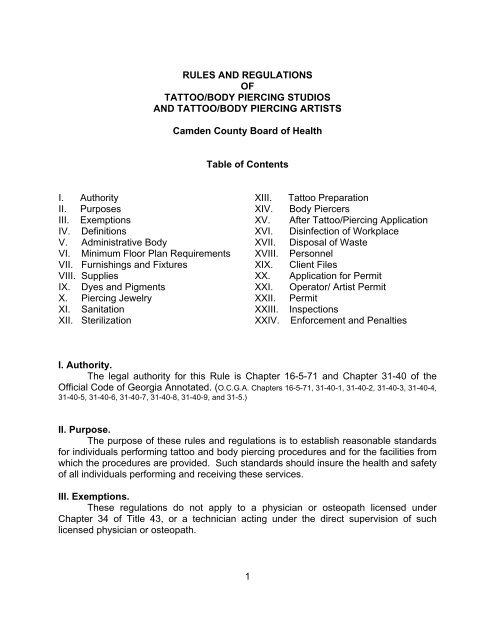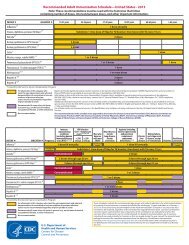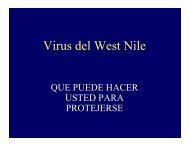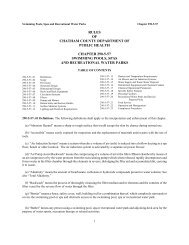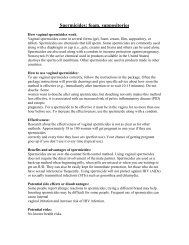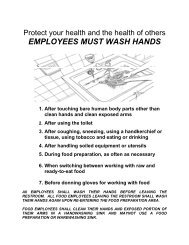Rules and regulations of tattoo/body piercing studios
Rules and regulations of tattoo/body piercing studios
Rules and regulations of tattoo/body piercing studios
- No tags were found...
You also want an ePaper? Increase the reach of your titles
YUMPU automatically turns print PDFs into web optimized ePapers that Google loves.
RULES AND REGULATIONSOFTATTOO/BODY PIERCING STUDIOSAND TATTOO/BODY PIERCING ARTISTSCamden County Board <strong>of</strong> HealthTable <strong>of</strong> ContentsI. AuthorityII. PurposesIII. ExemptionsIV. DefinitionsV. Administrative BodyVI. Minimum Floor Plan RequirementsVII. Furnishings <strong>and</strong> FixturesVIII. SuppliesIX. Dyes <strong>and</strong> PigmentsX. Piercing JewelryXI. SanitationXII. SterilizationXIII.XIV.XV.XVI.XVII.XVIII.XIX.XX.XXI.XXII.XXIII.XXIV.Tattoo PreparationBody PiercersAfter Tattoo/Piercing ApplicationDisinfection <strong>of</strong> WorkplaceDisposal <strong>of</strong> WastePersonnelClient FilesApplication for PermitOperator/ Artist PermitPermitInspectionsEnforcement <strong>and</strong> PenaltiesI. Authority.The legal authority for this Rule is Chapter 16-5-71 <strong>and</strong> Chapter 31-40 <strong>of</strong> theOfficial Code <strong>of</strong> Georgia Annotated. (O.C.G.A. Chapters 16-5-71, 31-40-1, 31-40-2, 31-40-3, 31-40-4,31-40-5, 31-40-6, 31-40-7, 31-40-8, 31-40-9, <strong>and</strong> 31-5.)II. Purpose.The purpose <strong>of</strong> these rules <strong>and</strong> <strong>regulations</strong> is to establish reasonable st<strong>and</strong>ardsfor individuals performing <strong>tattoo</strong> <strong>and</strong> <strong>body</strong> <strong>piercing</strong> procedures <strong>and</strong> for the facilities fromwhich the procedures are provided. Such st<strong>and</strong>ards should insure the health <strong>and</strong> safety<strong>of</strong> all individuals performing <strong>and</strong> receiving these services.III. Exemptions.These <strong>regulations</strong> do not apply to a physician or osteopath licensed underChapter 34 <strong>of</strong> Title 43, or a technician acting under the direct supervision <strong>of</strong> suchlicensed physician or osteopath.1
IV. Definitions.Unless otherwise defined by specific sections as used in these rules <strong>and</strong><strong>regulations</strong> the term:(a) "Antibacterial Solution" means any solution used to retard the growth <strong>of</strong>bacteria approved for application to human skin <strong>and</strong> includes all products labeledaccordingly.(b) "County" means the local County Board <strong>of</strong> Health or its duly authorizedrepresentatives.(c) "Currently Licensed Health Care Pr<strong>of</strong>essional" includes physicians,Registered Nurses (RN), Licensed Practical Nurses (LPN), <strong>and</strong> LicensedEmergency Medical Technicians.(d) "Department" means the local Board <strong>of</strong> Health(e) "Administrative Body" means the partnership, the corporation, theassociation, or the person or group <strong>of</strong> persons who maintain <strong>and</strong> control the<strong>tattoo</strong>/<strong>body</strong>-<strong>piercing</strong> studio <strong>and</strong> who are legally responsible for the operation <strong>of</strong>the studio.(f) "Permit" means the authorization granted by the Department/ County to thegoverning <strong>body</strong> to operate a <strong>tattoo</strong>/<strong>body</strong>-<strong>piercing</strong> studio.(g) "Plan <strong>of</strong> Correction" means a plan for correcting deficiencies in meeting rules<strong>and</strong> <strong>regulations</strong> <strong>of</strong> the local Board <strong>of</strong> Health.(h) "Sanitary" means clean <strong>and</strong> free <strong>of</strong> agents <strong>of</strong> infection or disease.(I) "Sanitized" means effective antibacterial treatment by a process that providessufficient concentration <strong>of</strong> chemicals for enough time to reduce the bacteria countincluding pathogens to a safe level on equipment.(j) "Sterilization" means holding an instrument in an autoclave for requiredlength <strong>of</strong> time at 15 - 30 pounds pressure at a temperature <strong>of</strong> 249.8 degreesFahrenheit or 121 degrees Celsius.(k) "Tattoo" means to mark or color the skin by pricking in, <strong>piercing</strong>, or implantingindelible pigments or dyes under the skin.(l) "Tattoo Artist" means any person who performs <strong>tattoo</strong>ing.2
(m) “Body Piercing” means the creation <strong>of</strong> an opening in an individual’s <strong>body</strong>other than the individual’s ear, to insert jewelry or other decoration.(n) “Body Piercing Artist” means any person who performs <strong>body</strong> <strong>piercing</strong>.(o) " Body Art Studio" means any permanent building or structure on apermanent foundation, holding a valid city or county business license <strong>and</strong> permitfrom the County Board <strong>of</strong> Health, wherein a <strong>tattoo</strong>/<strong>body</strong> <strong>piercing</strong> artist performs<strong>tattoo</strong>ing or <strong>body</strong> <strong>piercing</strong>. This shall not include <strong>tattoo</strong> removal.(p) "OSHA" means Occupational Safety <strong>and</strong> Health Administration.V. Administrative Body.(1) The administrative <strong>body</strong> shall be responsible for compliance with therequirements in Chapter 31-40 <strong>of</strong> the Official Code <strong>of</strong> Georgia Annotated, withapplicable administrative rules <strong>and</strong> <strong>regulations</strong> <strong>of</strong> the local County Board <strong>of</strong> Health,including but not limited to all applicable statutes, rules <strong>and</strong> <strong>regulations</strong> regardingdisclosure <strong>of</strong> ownership.(2) The administrative <strong>body</strong> shall certify in its application the name(s) <strong>and</strong> exactduties <strong>of</strong> employees/artists who have been designated as being responsible for carryingout the rules <strong>and</strong> policies adopted by the administrative <strong>body</strong>. The following informationshall be included: Social Security Number, DOB, gender, home address, home/workphone numbers, ID photos <strong>of</strong> all operators/technicians.(3) Prior to being granted a permit each <strong>body</strong> art studio shall develop a writtenstatement <strong>of</strong> policies <strong>and</strong> procedures outlining the responsibilities <strong>of</strong> management.(4) No person under the age <strong>of</strong> eighteen (18) shall be <strong>tattoo</strong>ed or pierced,except that a physician or osteopath licensed under Chapter 34 <strong>of</strong> Title 43, or atechnician acting under the direct supervision <strong>of</strong> such licensed physician or osteopathshall be authorized to do.(5) Tattoo/<strong>body</strong> <strong>piercing</strong> artists shall not be under the influence <strong>of</strong> alcohol <strong>and</strong>/ordrugs while performing <strong>tattoo</strong>/<strong>body</strong>-<strong>piercing</strong> procedures.(6) Operators shall refuse services to any person, who in the opinion <strong>of</strong> theoperator, is under the influence <strong>of</strong> alcohol or drugs.(7) No animals, except for guide dogs accompanying disabled persons, shall beallowed in the <strong>tattoo</strong>/<strong>body</strong>-<strong>piercing</strong> studio.3
VI. Minimum Floor Plan Requirements.(1) The <strong>body</strong> art studio shall be constructed, arranged, <strong>and</strong> maintained as toprovide adequately for the health <strong>and</strong> safety <strong>of</strong> its customers.(2) The studio shall be constructed in a manner to allow the customer receivingthe <strong>tattoo</strong>/<strong>body</strong> <strong>piercing</strong> adequate privacy from observers. The work area shall beseparate from the waiting area.(3) Body art <strong>studios</strong> must have adequate ventilation.(4) Walls <strong>and</strong> ceilings must be painted or covered in a manner which would allowfor easy <strong>and</strong> effective cleaning. Paint or covering must be light in color.(5) Floors <strong>of</strong> the work area must not be carpeted. Surfaces shall be <strong>of</strong> anonabsorbent material that would allow for effective cleaning by conventional methods.(6) A clean <strong>and</strong> sanitary toilet <strong>and</strong> h<strong>and</strong> washing facility shall be made accessibleto customers; however, it shall be separate from the work area.(7) The work area shall be equipped with at least one sink <strong>and</strong> basin providinghot <strong>and</strong> cold running water for the use <strong>of</strong> the artists for washing their h<strong>and</strong>s <strong>and</strong>preparing customers for <strong>tattoo</strong>ing/<strong>piercing</strong>. This area shall be provided with soap, anantibacterial solution, single use towels or air blower, <strong>and</strong> individual h<strong>and</strong> brushes foreach artist.(8) The facility shall be equipped with at least one utility sink, providing hot <strong>and</strong>cold running water for use in cleaning reusable receptacles <strong>and</strong> the facility.(9)The work area shall be provided with adequate lighting.(10) The work area shall not be used as a corridor for access to other rooms.(11) The <strong>body</strong> art studio shall be constructed in a manner to allow the customerreceiving the procedure adequate privacy from observers; thus the procedure roomshall be separated by a fixed <strong>and</strong> solid door, wall, or partition extending from floor toceiling from any other area including the waiting area.(12) The <strong>body</strong> art <strong>studios</strong> shall not be allowed to occur in automobiles, mobile,transitory or other non-fixed facilities. Such non-fixed facilities include, but are notlimited to, mobile homes, tents, recreational vehicles, <strong>and</strong> trailers.4
(13) Body art <strong>studios</strong> shall not be allowed in facilities used for human habitation,any food service establishment, hair salon, nail salon, retail sales area, hotel room orsimilar areas.VII. Furnishings <strong>and</strong> Fixtures.(1) Furnishings <strong>of</strong> the <strong>body</strong> art studio shall be maintained in good condition,intact, <strong>and</strong> functional. Furnishings should be made <strong>of</strong> or covered in a material that iseasily cleanable <strong>and</strong> non-absorbent. The studio shall be kept clean, neat, <strong>and</strong> free <strong>of</strong>litter <strong>and</strong> rubbish.(2) Cabinets for the storage <strong>of</strong> instruments, dyes, pigments, single use articles,carbon, <strong>and</strong> stencils shall be provided for each <strong>tattoo</strong> artist <strong>and</strong> shall be maintained in asanitary manner which protects them from contamination.(3) Work tables <strong>and</strong> chairs shall be provided for each <strong>tattoo</strong>/<strong>body</strong> <strong>piercing</strong> artist.(a) Surfaces <strong>of</strong> all worktables <strong>and</strong> chairs shall be constructed <strong>of</strong>material, which is smooth, nonabsorbent, corrosive resistant, <strong>and</strong>easily sanitized.b) Work tables <strong>and</strong> chairs shall be sanitized with a bactericidalsolution after each application.VIII. Supplies.(1) Bulk single use articles shall be commercially packaged <strong>and</strong> h<strong>and</strong>led toprotect them from contamination. These articles shall be stored in an area separatefrom the toilet facilities.(2) All materials applied to the human skin shall be from single use containers<strong>and</strong> shall be disposed <strong>of</strong> after each use.IX. Dyes <strong>and</strong> Pigments.(1) All dyes <strong>and</strong> pigments used in <strong>tattoo</strong>ing shall be from pr<strong>of</strong>essional suppliersspecifically providing dyes <strong>and</strong>/or pigments for the <strong>tattoo</strong>ing <strong>of</strong> human skin.5
(2) In preparing dyes or pigments to be used by a <strong>tattoo</strong> artist, only nontoxicsterile materials shall be used. Single-use or individual portions <strong>of</strong> dyes or pigments inclean, sterilized individual containers or single-use containers shall be used for eachpatron.(3) After <strong>tattoo</strong>ing, the remaining unused dye or pigment in the single-use orindividual containers shall be discarded along with the container.X. Piercing Jewelry.(1) Client <strong>and</strong> piercer should have appropriate size <strong>and</strong> quality jewelry chosenbefore the procedure begins.XI. Sanitation.(2) Jewelry should be used in <strong>piercing</strong> shall consist <strong>of</strong> an approved materialsuitable for permanent surgical implant, such as, high quality surgicalstainless steel (316LVM series), niobium, titanium, platinum or a dense lowporosity plastic material such as Tygon or PTFE. Copies <strong>of</strong> the jewelrymanufacturer’s documentation, which verify compliance with st<strong>and</strong>ards,must be available for inspection on request <strong>of</strong> the local Health Department.Solid 14 karat, or high, white or yellow nickel-free gold may be used. Purityverification must also be available for inspection on request <strong>of</strong> the director.Appropriate jewelry has no nicks, scratches, or irregular surfaces.(3) Ear studs or other jewelry designed for earlobe <strong>piercing</strong> are not appropriatejewelry for other <strong>body</strong> parts <strong>and</strong> must not be used by piercers.(1) Prior to the start <strong>of</strong> the <strong>tattoo</strong>/<strong>body</strong> <strong>piercing</strong> procedure the artist should inspecthis/her h<strong>and</strong>s for hangnails, small cuts, sores, <strong>and</strong> abrasions. If a cut, sore, or abrasionis detected, a b<strong>and</strong>age should be applied for added protection before gloving. Trimfingernails to insure that gloves are not punctured.(2) All jewelry such as watches, rings, etc. should be removed prior to the start <strong>of</strong>the <strong>tattoo</strong> procedure.(3) Before working on each client, the fingernails <strong>and</strong> h<strong>and</strong>s <strong>of</strong> the <strong>tattoo</strong>/<strong>body</strong><strong>piercing</strong> artist shall be thoroughly washed <strong>and</strong> scrubbed with warm water, <strong>and</strong>antibacterial soap, using an individual h<strong>and</strong> brush that is clean <strong>and</strong> in good repair. Theh<strong>and</strong>s should then be dried by either an air blower or by single use towels prior tobeginning work on each client or when interrupted in the process.6
(4) Single use disposable latex or approved non-latex examination gloves shallbe worn during the <strong>tattoo</strong>ing process. Gloves shall be changed <strong>and</strong> properly disposed<strong>of</strong> each time there is an interruption in the application <strong>of</strong> the <strong>tattoo</strong>, the gloves becometorn or punctured, or whenever their ability to function is compromised.(5) Each artist shall wear a clean outer garment, apron or smock, or use otherprotective barriers as needed. These items shall be changed after each client.(6) Tattoo/<strong>body</strong> <strong>piercing</strong> artists who are experiencing symptoms <strong>of</strong> diarrhea,vomiting, fever, rash, or skin infections shall refrain from <strong>tattoo</strong>ing/<strong>body</strong> <strong>piercing</strong>activities.(7) Adequate numbers <strong>of</strong> sterilized needles <strong>and</strong> tubes must be on h<strong>and</strong> for eachartist for the entire day <strong>and</strong> night operation.(8) Only single-use disposable razors shall be used to shave the area to be<strong>tattoo</strong>ed.(9) Smoking <strong>and</strong> consumption <strong>of</strong> food or drink is prohibited in <strong>body</strong> art studio.(10) Universal precautions are to be followed per OSHA st<strong>and</strong>ards <strong>and</strong>guidelines.7
XII. Sterilization.(1) An operational sterilizer (autoclave) shall be provided in each <strong>body</strong> art studio.(2) Used non-disposable instruments shall be kept in a separate punctureresistant container until brush scrubbed in hot water <strong>and</strong> soap, <strong>and</strong> then sterilizedby autoclaving.(3) The following procedures should be followed during the sterilization process:(a) Prior to being placed in the autoclave all equipment shall be bagged,labeled, dated <strong>and</strong> sealed.(b) Each autoclave bag may hold no more than one tube with needle <strong>and</strong>bar.(c) Autoclave shall be operated according to manufacturer’s instructions<strong>and</strong> shall be made available for inspection(d) Spore indicators shall be used a minimum <strong>of</strong> at least once a month <strong>and</strong>the results must be kept at location for a minimum <strong>of</strong> three years.XIII. Tattoo Preparation.(1) Before placing the <strong>tattoo</strong> design on the client's skin, the artist shall treat theskin area with an antibacterial solution.(2) If an acetate stencil is used by a <strong>tattoo</strong> artist for transferring the design to theskin, it shall be thoroughly cleaned <strong>and</strong> rinsed in a germicidal solution for at leasttwenty (20) minutes <strong>and</strong> then dried with sterile gauze or dried in the air on asanitized surface after each use.(3) If a paper stencil is used by a <strong>tattoo</strong> artist for transferring the design to theskin, it shall be single use <strong>and</strong> disposable.(4) If the design is drawn directly onto the skin, it shall be applied with a singleuse article only.8
XIV. Body Piercers Shall:(1) Set up equipment in front <strong>of</strong> client.(2) Open sealed autoclave bags containing sterile equipment in front <strong>of</strong> client,<strong>and</strong> discard the autoclave bag.(3) Disinfect all jewelry contaminated with only airborne pathogens (notpreviously worn or contaminated) with a non-hazardous hard surfacedisinfectant approved by the EPA. All jewelry contaminated or potentiallycontaminated with blood borne pathogens (previously worn by another person)should be autoclaved, stored in sterile indicator bags, sealed <strong>and</strong> dated.(4) Pre-sterilize all needles used in <strong>piercing</strong>, use only on one person, atone sitting, for a single <strong>piercing</strong>, <strong>and</strong> immediately dispose <strong>of</strong> in a medical sharpscontainer.(5) Pre-sterilize all forceps, tubes, etc. in sealed, dated, sterile indicator bags.These items are to be used on one person, in one sitting. After one such use, theymust be autoclaved <strong>and</strong> stored in sterile indicator bags, sealed <strong>and</strong> dated.XV. After Tattoo/Body Piercing Application.(1) The completed <strong>tattoo</strong> shall be washed with a single-use towel saturated withan antibacterial solution.(2) After the area has dried, apply a layer <strong>of</strong> antibacterial ointment from a singleuse dispenser or applicator.(3) A b<strong>and</strong>age or cover shall then be applied to the <strong>tattoo</strong> using sealed telfa (nonsticking)pads.(4) Verbal <strong>and</strong> written instructions, approved by the Department for the care <strong>of</strong>the <strong>body</strong> art procedure site shall be provided to each client by the operator uponcompletion <strong>of</strong> the procedure. The written instructions shall advise the client to consult aphysician at the first sign <strong>of</strong> infection <strong>and</strong> contain the name, address <strong>and</strong> phone number<strong>of</strong> the establishment. These documents shall be signed <strong>and</strong> dated by both parties, witha copy given to the client <strong>and</strong> the operator retaining the original with all other requiredrecords. The facility shall also post in public view the name, address <strong>and</strong> phonenumber <strong>of</strong> the local County Health Department <strong>and</strong> the procedure for filing a complaint.The Notice for Filing a Complaint shall be included in the establishment ApplicationPacket.9
XVI. Disinfection <strong>of</strong> Workplace.Each <strong>body</strong> art studio must be kept clean <strong>and</strong> sanitary. The owner must develop <strong>and</strong>implement a cleaning schedule that includes appropriate methods <strong>of</strong> decontamination<strong>and</strong> tasks or procedures to be performed. This written schedule must be based on thelocation within the studio, the type <strong>of</strong> surfaces to be cleaned, type <strong>of</strong> possiblecontamination present, the tasks or procedures to be performed, <strong>and</strong> their locationwithin the studio.The following procedures should be adhered to.(1) Clean <strong>and</strong> sanitize all equipment <strong>and</strong> work surfaces with anappropriate disinfectant after completion <strong>of</strong> <strong>tattoo</strong>/<strong>body</strong> <strong>piercing</strong>procedures <strong>and</strong> at the end <strong>of</strong> work shift when surfaces have becomecontaminated since the last cleaning.(2) Remove <strong>and</strong> replace protective coverings such as plastic wrap <strong>and</strong>aluminum foil after each <strong>tattoo</strong> procedure(3) Inspect <strong>and</strong> decontaminate, on a daily basis, reusable receptaclessuch as bins, pails, <strong>and</strong> cans that have likelihood for becomingcontaminated. When contamination is visible, clean <strong>and</strong>decontaminate receptacles immediately, or as soon as feasible.XVII. Disposal <strong>of</strong> Waste.(1) Needles, razors, or other sharp instruments used during <strong>tattoo</strong>/<strong>body</strong> <strong>piercing</strong>procedures, shall be placed in puncture resistant, closed containers immediately afteruse.h<strong>and</strong>.(2) Needles shall not be purposely bent or broken, or otherwise manipulated by(3) Containers <strong>of</strong> sharp waste shall be sent to a facility where they are eitherincinerated or otherwise rendered non-hazardous in compliance with 29 CFR Part1920.1030, Occupational Exposure to Blood Borne Pathogens.(4) Contaminated waste which may release liquid blood or <strong>body</strong> fluids whencompressed or may release dried blood or <strong>body</strong> fluids when h<strong>and</strong>led must be placed inan approved “red “ bag, which is marked with the International Biohazard Symbol. Itmust then be disposed <strong>of</strong> in compliance with 29 Code <strong>of</strong> Federal Regulations Part1910.1030, known as “Occupational Exposure to Blood borne Pathogens”.10
(5) Waste containers shall be kept closed when not in use.(6) Disposable waste shall be h<strong>and</strong>led, stored, <strong>and</strong> disposed <strong>of</strong> to minimize directexposure <strong>of</strong> personnel to waste materials.(7) At least one covered waste receptacle shall be provided in each operatorarea <strong>and</strong> each toilet room. Receptacles in the operator area shall be emptied daily <strong>and</strong>solid waste shall be removed from the premises at least weekly. All refuse containersshall be lidded, cleanable <strong>and</strong> kept clean.XVIII. Personnel(1) Persons performing the <strong>tattoo</strong>/ <strong>body</strong> <strong>piercing</strong> operation shall obtain currentcertification in first aid <strong>and</strong> pro<strong>of</strong> <strong>of</strong> attendance at a Blood borne Pathogen trainingprogram (or equivalent), given or approved by the Health Department. Training/coursesprovided by pr<strong>of</strong>essional <strong>body</strong> art organizations/associations or by equipmentmanufacturers may also be submitted for consideration.(2) If the artist is currently in business at the time <strong>of</strong> application for permit, theabove certification must be obtained within sixty (60) days from the date the permit isissued.(3) Pro<strong>of</strong> shall be provided upon request that all operators have eithercompleted or were <strong>of</strong>fered <strong>and</strong> declined in writing, the Hepatitis B vaccination series;that anti<strong>body</strong> testing has revealed that the employee is immune to Hepatitis B; or thatthe vaccine is contraindicated for medical reasons. Contraindication requires a dated<strong>and</strong> signed physician’s statement specifying the name <strong>of</strong> the employee <strong>and</strong> that thevaccine cannot be given.(4) The owner or governing <strong>body</strong> must maintain a file on all employees whoperform <strong>tattoo</strong>/ <strong>body</strong> <strong>piercing</strong> procedures, which will be available for inspection <strong>and</strong>includes the following:a. Report <strong>of</strong> Hepatitis B Vaccination, Hepatitis B anti<strong>body</strong> testingresults or Statement <strong>of</strong> Contraindication to Hepatitis B vaccine.b. Evidence <strong>of</strong> first aid certification <strong>and</strong> completed training inDisease Prevention/ Blood borne Pathogens.11
XIX. Client Files.(1) For each client, proper records <strong>of</strong> identification, <strong>tattoo</strong>s/ <strong>piercing</strong>sadministered, informed consent, <strong>and</strong> care instructions shall be kept <strong>and</strong> retained for aminimum <strong>of</strong> two (2) years.(2) Records <strong>of</strong> each client shall be prepared prior to the procedure beingperformed <strong>and</strong> shall reflect the client's name <strong>and</strong> signature, address, pro<strong>of</strong> <strong>of</strong> age, date<strong>tattoo</strong>ed/ pierced, design, its location <strong>and</strong> name <strong>of</strong> the artist.(3) A statement <strong>of</strong> informed consent by the individual receiving the <strong>tattoo</strong>/<strong>piercing</strong> must be maintained on file.(4) A statement by the client attesting that he/she is not under the influence <strong>of</strong>alcohol <strong>and</strong>/or drugs shall be on file.(5) A copy <strong>of</strong> procedures signed by the client advising them <strong>of</strong> proper subsequentcare <strong>of</strong> the <strong>tattoo</strong>/ <strong>piercing</strong> shall be maintained on file.(6) A copy <strong>of</strong> instructions signed by the client informing them on the risksinvolved <strong>and</strong> possible complications that might result from the <strong>tattoo</strong>/<strong>body</strong> <strong>piercing</strong>procedure must be maintained on file.XX. Application For Permit.(1) The administrative <strong>body</strong> <strong>of</strong> each <strong>body</strong> art studio shall submit to the localCounty Health Department an application for a permit to operate under the rules <strong>and</strong><strong>regulations</strong>. No studio shall be operated <strong>and</strong> no <strong>tattoo</strong>ing/<strong>body</strong> <strong>piercing</strong> performedwithout such a permit, which is current under these rules <strong>and</strong> <strong>regulations</strong>.(2) The application for permit shall be made on forms provided by the CountyHealth Department(3) Each application for a permit shall be accompanied by a floor sketch <strong>of</strong> thestudio showing windows, doors, room measurements, chairs, tables <strong>and</strong> equipmentplacement for clients <strong>and</strong>/or staff.(4) A listing <strong>of</strong> the names <strong>of</strong> all staff including the owner who will be working inthe studio shall be included with the application for a permit. This listing shall includethe full name <strong>of</strong> each staff person.(5) The ownership <strong>of</strong> the studio shall be fully disclosed in its application for apermit.12
(6) Zoning <strong>and</strong> other local requirements regarding proper location <strong>and</strong>establishment <strong>of</strong> <strong>studios</strong> shall be addressed by the applicant with the responsible local<strong>of</strong>ficials.XXI. Operator/ Artist Permit.(1) No person shall practice <strong>body</strong> art procedures without first obtaining anoperator/artist permit form the County Health Department.(2) The operator/artist permit shall be valid from the date <strong>of</strong> issuance <strong>and</strong>shall automatically expire in 1 (one) year <strong>and</strong> must be renewedannually unless revoked sooner by the Department.(3) Application for the operator/artist permits shall include:a. Nameb. Date <strong>of</strong> Birthc. Sexd. Residence addresse. Mailing addressf. Phone numberg. Place(s) <strong>of</strong> employment as an operator/artisth. Training <strong>and</strong> experiencei. Pro<strong>of</strong> <strong>of</strong> attendance at a Blood borne pathogen training program <strong>and</strong>first aid course given or approved by the Department.(4) All operator/ artist permits shall be posted in a prominent <strong>and</strong>conspicuous area where they may be readily observed by clients.XXII. Permit.(1) The administrative <strong>body</strong> <strong>of</strong> each <strong>body</strong> art studio shall obtain a valid permitfrom the County/Department prior to beginning operation. To be eligiblefor a permit the studio must be in compliance with these rules <strong>and</strong><strong>regulations</strong>.13
(2) The permit shall be displayed in a conspicuous place on the premises.(3) Permits are not transferable from one studio to another.(4) A permit shall no longer be valid <strong>and</strong> shall be returned to the County whenthe studio ceases to operate, has moved to another location theownership changes, or the permit is suspended or revoked.(5) A studio which fails to comply with these rules <strong>and</strong> <strong>regulations</strong> shall besubject to the sanctions available to the County Health Departmentpursuant to O.C.G.A. 31-5 including but not limited to denial or revocation<strong>of</strong> its permit by the County/Department.XXIII. Inspections.(1) The studio <strong>and</strong> its records shall be available for review <strong>and</strong> examination byproperly identified representatives <strong>of</strong> the County Health Department.(2) A copy <strong>of</strong> the inspection report shall be displayed in a conspicuous place onthe premises <strong>and</strong> also shall be available for public inspection at the appropriate countywherein the studio is located.XXIIII. Enforcement <strong>and</strong> Penalties.(1) Enforcement <strong>of</strong> these <strong>Rules</strong> <strong>and</strong> Regulations shall be in accordance withO.C.G.A. 31-5.(2) No studio shall operate without a permit. Failure or refusal to file anapplication for a permit shall constitute a violation <strong>of</strong> Chapter 40 <strong>of</strong> Title 31 <strong>of</strong> the OfficialCode <strong>of</strong> Georgia Annotated. Any person who fails or refuses to file including, but notlimited to, an order to cease <strong>and</strong> desist operating a studio(3) The County may refuse to grant a permit for the operation <strong>of</strong> any <strong>body</strong> artstudio that does not fulfill the minimum requirements <strong>of</strong> these rules <strong>and</strong> <strong>regulations</strong> <strong>and</strong>may revoke a permit, which has been issued, <strong>and</strong> invoke other sanctions if a studioviolates any <strong>of</strong> these rules <strong>and</strong> <strong>regulations</strong>. Before any order is entered refusing apermit applied for or revoking a permit the applicant or permit holder shall be affordedan opportunity for a hearing as provided in Article 1 <strong>of</strong> Chapter 5, <strong>of</strong> Title 31 <strong>of</strong> theOfficial Code <strong>of</strong> Georgia Annotated. The notice <strong>of</strong> refusal or revocation shall containdirections on how a hearing may be requested.(4) The County/Department is empowered to institute appropriate proceedings ina court <strong>of</strong> competent jurisdiction for the purpose <strong>of</strong> enjoining violation <strong>of</strong> any applicable14
provision <strong>of</strong> Title 31 <strong>of</strong> the Official Code <strong>of</strong> Georgia Annotated, or <strong>of</strong> the <strong>Rules</strong> <strong>and</strong>Regulations.Effective DateThese <strong>Rules</strong> <strong>and</strong> Regulations shall become effective on October 10, 2007.Adopted September 12, 2007.Notice <strong>of</strong> public hearing published in the Tribune & Georgian on the June 22, 27, July 3,6, 11, 13, 18, 20 <strong>and</strong> 25, 2007.Public Hearing held on July 26, 2007Dr. Willis Keene, Chairman, Camden Board <strong>of</strong> HealthReferences:<strong>Rules</strong> <strong>of</strong> the Georgia Department <strong>of</strong> Human Resources, Public Health, Chapter 290-31-40, Tattoo Studios <strong>and</strong> Artists, circa 1999.Ordinance <strong>of</strong> the Dekalb County, Georgia Board <strong>of</strong> Health to Regulate the Body CraftIndustry, 2005Jewelry St<strong>and</strong>ards, The Association <strong>of</strong> Pr<strong>of</strong>essional Piercers(www.safe<strong>piercing</strong>.org/st<strong>and</strong>ards), April 20, 2007###15


